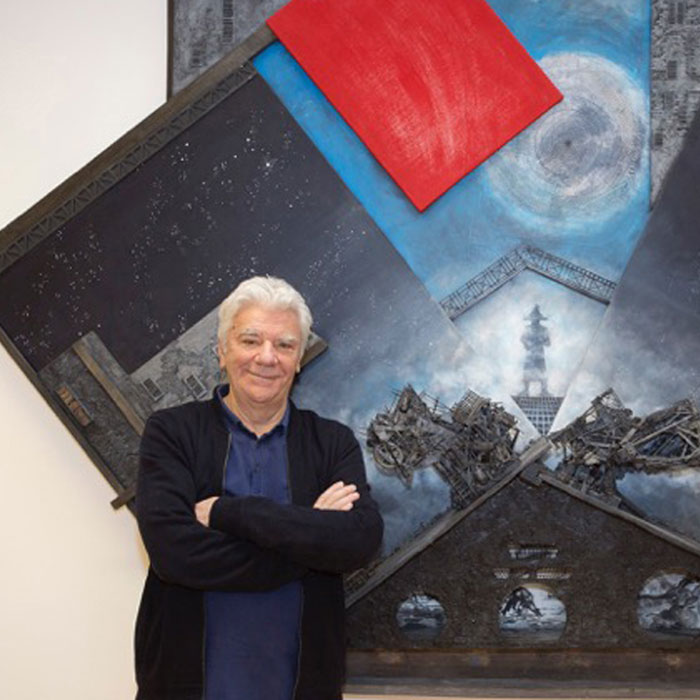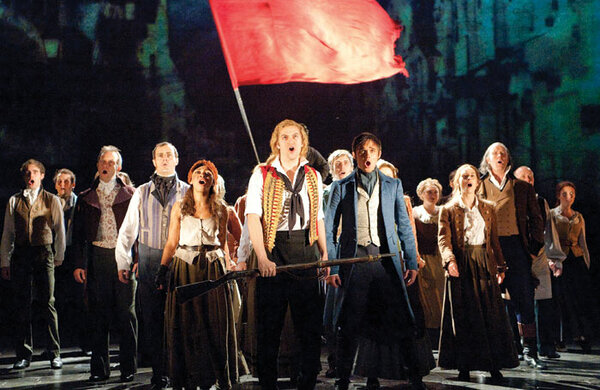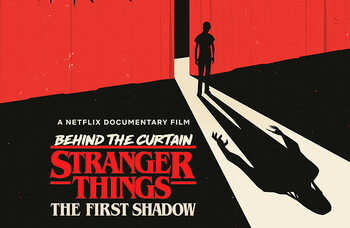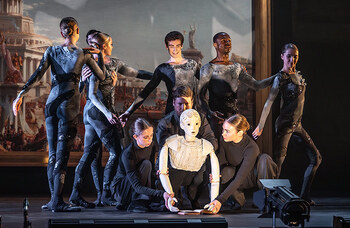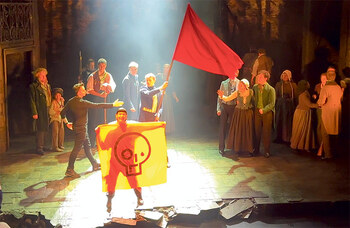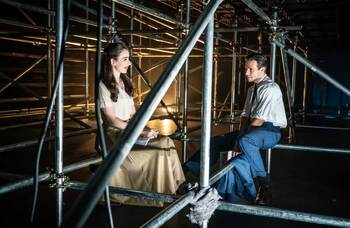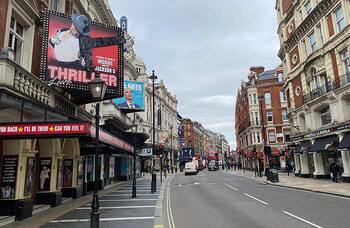John Napier
 Matthew Hemley
Matthew HemleyMatt is deputy editor of The Stage, having started as the newspaper’s broadcast reporter in 2007. He covers all areas of the industry in ...full bio
After more than three decades in the West End, John Napier’s staging of Les Miserables is set to be replaced by the touring version at the end of this year. Looking back on a career that has also included Cats, Starlight Express and Sunset Boulevard, the designer tells Matthew Hemley why he’s pleased that fans are mourning the revolve
At the end of this year, a musical theatre icon will leave the West End. While Les Miserables will continue to run on Shaftesbury Avenue in a slimmed-down, slicked-up touring version, the much-loved original staging is to close for good.
As well as Trevor Nunn and John Caird’s visionary direction, Les Mis became legendary for its extraordinary design, based on a revolving stage and its awe-inspiring barricades. For John Napier, the man who designed the show that opened in 1985, the loss of the original production inspires something akin to grief. It is grief mixed, it’s fair to say, with a splash of bewilderment and a heap of frustration.
Les Miserables to transfer to Gielgud while current West End home undergoes renovation
Napier, who won a Tony award for that design, is at pains to say he does not want to appear petty, or seem “churlish” towards the show’s producer Cameron Mackintosh, who took the decision announced last month. But as an era in musical theatre comes to an end, it’s clear he wants to have his say.
“I have made an enormous amount of money from these three Cameron Mackintosh productions [Les Miserables, Miss Saigon and Cats] over the years, but clearly there was something going on in Cameron’s mind where he was not satisfied with what we did originally on Les Mis. And once again he’s turned it into sort of another Oliver!” When he describes it as “another Oliver!” he explains that he feels many of Mackintosh’s “revitalised” shows are “formulaic as opposed to out-of-the-box and radical”.
Napier continues: “My grief about that, if there is such a thing as grief with someone tinkering with a show, it is that it led Les Mis down a path that felt a bit backwards, into some sort of era of stage cloths and people pushing things on from left and right… The thing about the original is that it’s much simpler and more organic than the other production.” In losing the original’s simplicity, it has lost some of its beauty, he feels.
The 74-year-old designer found out that his staging of Les Miserables would finish in a letter from Mackintosh last year. But the seeds were likely sown when the new touring production began in 2009. At that time, Napier was keen to know what the financial implications would be for him when the new version began to tour.

“We had a dispute about this whole production,” he explains. “I felt I was relatively deserving, given it was the original production that had underpinned the new production really. But there was a disagreement about that.”
He adds: “I have subsequently had no financial benefit from the touring production whatsoever.”
Napier says Mackintosh offered to buy out his intellectual property – “for the wonderful sum of $50,000”, though it could have been pounds, he can’t remember. “But, as you can imagine, I refused.”
Napier reveals there were “sharp words said from people on both sides” and that the situation is ongoing. Though he points out the company knows he is not in a position to make a legal challenge and doesn’t really want to anyway. “I am not sure I want the bother, quite frankly,” he says. “I’d be dealing with a behemoth.”
As it stands, when the new version opens in London, Napier will make nothing from it.
From art school to the West End
Napier studied art at Hornsey College of Art in the early 1960s, before studying theatre design at the Central School of Arts and Crafts under Ralph Koltai. After graduating, he became an associate designer for the Royal Shakespeare Company and worked on productions of Macbeth, The Comedy of Errors, King Lear and Hedda Gabler there. At the National Theatre he worked on shows including The Party, starring Laurence Olivier in his final performance at the Old Vic, and Equus.
Andrew Lloyd Webber’s Cats marked his first foray into musical theatre, followed by Starlight Express, before Les Miserables and Miss Saigon came calling. Napier, modest though he is, feels he and a handful of other designers at the time “changed the dynamic of theatre”.
“I was involved in things like creating the Donmar Warehouse and had a love affair with small theatre,” he says. “It was always about how to engage with the audience, telling a story that brought them into the action and made them feel it wasn’t just like looking at a cinema screen with people of a certain height wandering around.”
It’s the slicking up of stuff that I object to – great theatre has a rough edge to it
He says his style has always been anything but pretty. “If you look at the three big shows I did with Cameron, almost all of them are in a territory that is kind of grim. Cats, because it’s TS Eliot, I put in a wasteland. Les Mis was in Paris, and I made it gritty and grey and dull – deliberately so the performers would stand out.” He adds: “It’s the slicking up of stuff that I object to. I believe, as Peter Hall once said, that really great theatre has a rough edge to it.” He adds that the newer Les Miserables has “something more colourful about it – and I don’t think the story needs that”.

When he was designing the original Les Mis in the early 1980s, he and Nunn took a trip to Paris. Together, they listened to the music and read the book. Nunn felt the production needed “motion”, which led to the creation of the now-legendary revolving stage, which gives the musical a “dynamic that is sculptural and not painterly” according to Napier.
He isn’t alone in his love for the revolve. When news of the original production’s end was announced, there was uproar from fans of the musical, who were sad to see Napier’s design leave the West End. A petition was set up, urging Mackintosh to retain it, which has attracted several thousand signatures.
“I find it interesting that people have observed or felt that the original production, in some way, has more gravitas,” he says, adding: “It’s truer in a way to the spirit of Victor Hugo. Trevor and John did an enormous amount of work with the writers Alain [Boublil] and Claude [Schonberg] on restructuring it, to create something rather unique in its day.” Nunn and Caird’s production has an “epic quality”, he adds, with a sense of “movement and travel”.
Napier is disappointed, to say the least, that Mackintosh failed to consult him on the newer show. “Having worked on the three productions that have been the furnace of his engine – what has become a multimillion-pound organisation – it would be nice if you were asked [to work on the new] interpretation, and not your assistant,” he says. That assistant was Matt Kinley, the designer of the new show, who worked in Napier’s studio for many years and “got jolly well paid for doing it”.
Napier says he would rather Mackintosh had chosen to put on a brand new production. “I would have been perfectly happy if it had been people with no association with the original in the first place. Therefore its originality would have been authentic. It’s when you have people who have worked on it before, that I find it a little bit galling.”
He continues: “I would have celebrated another production of Les Miserables – a new take on it. But it seems to me this is a fudged take on the old production. I am not wishing to do anything other than to say it’s a bit tragic that maybe a younger, more energetic and up-to-date group of creatives weren’t chosen. I would have celebrated that, I really would. Shakespeare gets reinvented every week of the year. It’s possible to do these things.”

Working with Andrew Lloyd Webber
While Napier admires new interpretations, he also thinks the original creatives can help improve a show for the present day. Not so long ago, he was asked to work with Lloyd Webber on some changes to Starlight Express in Germany. Original creatives including Arlene Phillips were brought back to work on it. Napier was able to incorporate new design ideas and use technology that had not been available to them before. “Andrew was over the moon with what we managed to achieve in a relatively short period of time,” he says. “Re-addressing old productions, sometimes with the original person knowing the ins and outs of it, can actually improve it and here’s an example.”

Napier continues to have a good relationship with Lloyd Webber. It started with Cats, and went on to include Starlight Express, Sunset Boulevard, and a Jesus Christ Superstar revival. As an aside, Napier shares a story about his hand in the iconic Cats poster, a pair of cats eyes on a black background with dancers for pupils, created to launch the musical when it opened originally in 1981.
About a month before the show was due to open, the creative team, along with Mackintosh and marketing company Dewynters, assembled to look at the poster options for the show. Nothing was suitable – “There were pink pussycats walking into the distance with question mark tails” – so Mackintosh asked the marketing team to come up with something else. Napier says he received a call from Robert De Wynter, “in distress” and asking for clues as to what the show included.
So Napier told him the show had a revolving stage, and that cats appeared out of tunnels at the beginning wearing LED glasses, to give the illusion of cats eyes. “I think it should be something you know is a cat, but you can’t see it. You’re not giving any literal dimension to it,” Napier told him.

Another meeting, and again all the designs were dismissed, until Napier pulled one out of the pile, believing it to be “one of the best posters I have seen since Equus”. It was the poster now synonymous with the show worldwide. Not everyone liked the idea of the black poster advertising the show on the back of London buses, according to Napier, but he persisted. “I said: ‘Yes, it’s mysterious, but I reckon that on the back of buses it will look fantastic.’ ”
In a career that included working on some of the most iconic musicals of recent times, Napier has plenty of stories to share. But it’s doubtful he will have any new ones about Mackintosh; he doesn’t think it likely they will work together again. “That is not to say there is any great animosity, but he clearly does not like my style,” Napier says.
Continues…
John Napier on…
…staging Les Miserables
Some of the simplest effects, such as when a table comes around with a candle on it, can take your breath away. It does not have to be wall-to-wall spectacle all the time. You pick your moments. I don’t want to cause controversy, but it’s rather wonderful that aficionados have said: “Hang on a minute, the original was something unique.”
…the theatre industry
Theatre is fantastic and it’s been my life. Comradeship is the most important thing about it, working with other people rather than being alone in a studio. Now I choose to be in a studio, and it’s hard to sit with a blank piece of paper without a script to refer to.
…Cameron Mackintosh
He’s clearly incredibly passionate about what he does. Sometimes he’s over-passionate, and sees it partly through a prism that is, quite frankly, 1950s theatre – his boyhood.
Parting ways with Les Miserables
The designer also reveals that, before the updated Les Mis began touring, he told Mackintosh he was not interested in doing new productions, but that he would always be available to revisit old ones. “Having worked on three of the longest-running musicals in the history of the 20th and 21st centuries, I felt it was time to hang up my boots and hand the baton to the younger generation,” he says, adding that he feels a duty to give emerging designers the chance to work on shows.
But Napier also feels his words to Mackintosh about turning down new shows came back to bite him. “Cameron took the word ‘new’ and put it smack bang on this production of Les Mis, calling it the ‘all-new Les Miserables’. How can anyone not feel churlish if that is the way the cookie crumbles?”
Though his own design for Les Mis will no longer be seen, Napier, a three-time Olivier award winner, believes its influence can be felt in shows today. He references Hamilton, with its revolving stage and exposed brickwork. “It’s not dissimilar to the original Les Mis, and all these things happen by osmosis,” he says. “I believe Les Mis set a bar for staging shows in a certain way.” He adds: “I wonder what will happen in five, 10 or 15 years’ time, when Hamilton needs to move to a smaller theatre.”
None of that will be Napier’s concern, however, and for now, he’s happy concentrating on his own art work. He’s hoping that an exhibition about his career, which went on display in Eastbourne in 2015, will make its way to London and is also writing an autobiography – though as he’s dyslexic, he says this is proving harder than he thought.
None of this is to say that theatre work in the future is completely out of the question. And referring to his recent reworking of Starlight Express with Lloyd Webber, he wants to make something perfectly clear. “I am not past my sell-by date,” he says. “I guess that’s what I am trying to say.”
CV: John Napier
Born: 1944, London
Landmark productions:
• Cats (1981)
• Starlight Express (1984)
• Les Miserables (1985)
• Miss Saigon (1989)
• Sunset Boulevard (1993)
Awards:
• Olivier awards for the Royal Shakespeare Company’s King Lear (1977), Nicholas Nickleby (1980) and Burning Blue (1996)
• Tony awards for Cats (1983), Les Miserables (1987), Starlight Express (1987) and Sunset Boulevard (1995)
Further details: johnnapierstages.com
More about this person
Big Interviews
Recommended for you
Opinion
Most Read
Across The Stage this weekYour subscription helps ensure our journalism can continue
Invest in The Stage today with a subscription starting at just £7.99
